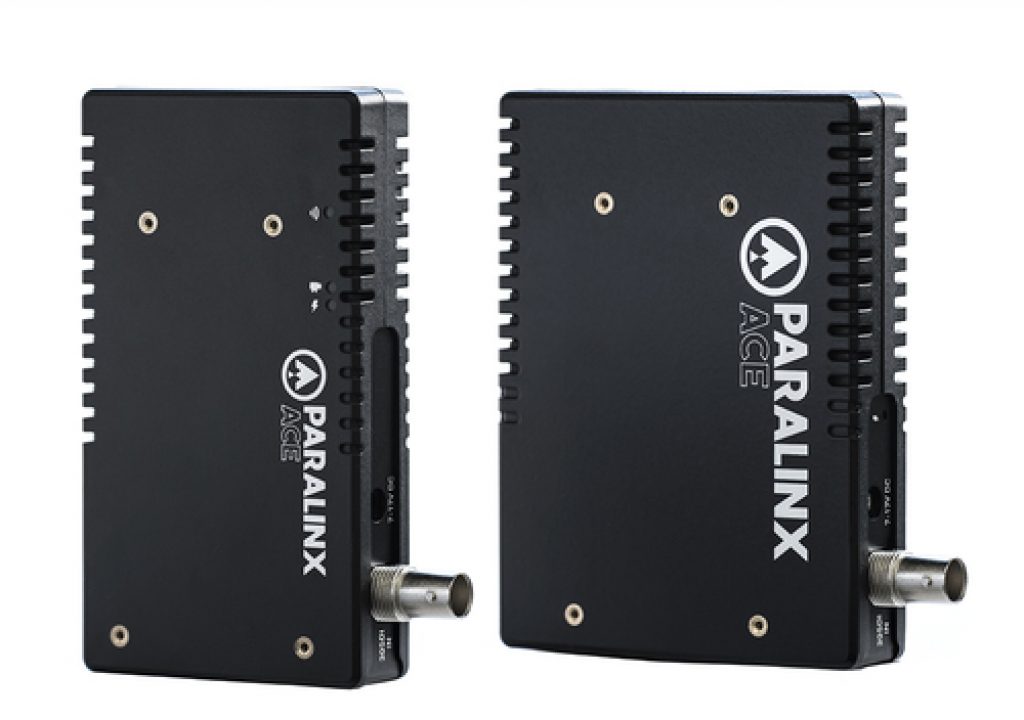Looking for a wireless video system that has good range, a lightweight form, HDMI or SDI support, and won’t break the bank? I was looking for exactly that, and found it in Paralinx’s new Ace.
The Ace, in my opinion, is the most well-rounded, cost-effective system available these days. Here are some highlights:
- 1920×1080, uncompressed, 4:2:2 output up to 60 fps
- Up 300 foot range
- You can buy it in either SDI or HDMI flavors, and mix and match transmitters and receivers with those two connectors
- Both transmitter and receiver are noticeably lighter than similar systems like Teradek’s Bolt.
- Transmitter/receiver packages cost $1299 for HDMI and $1799 for SDI
- Power it off of d-tap, or buy battery plates for common batteries such as Sony L series, Canon LP-6, etc.
- One transmitter signal can broadcast to 4 receivers
- Support for timecode, metadata and start/stop flags
OPERATION
I’ve been using a couple of Aces for more than 3 months, adding the blessed benefits of wireless video to two cameras and up to three field monitors that I use on most of my jobs. It’s largely been an easy, effortless experience, and here are a few impressions…
- If you buy a transmitter and receiver together, they already come paired, and you’ll probably never have to futz with any additional settings. And when you power up the units, they find each other in just a couple of seconds, and you’re in business.
- The units have a range up to 300 feet. I haven’t been able to test that limit myself, but did do a few driving shots with a camera in one car, and a director following behind in another car, somewhere in the neighborhood of 150 feet. No problems.
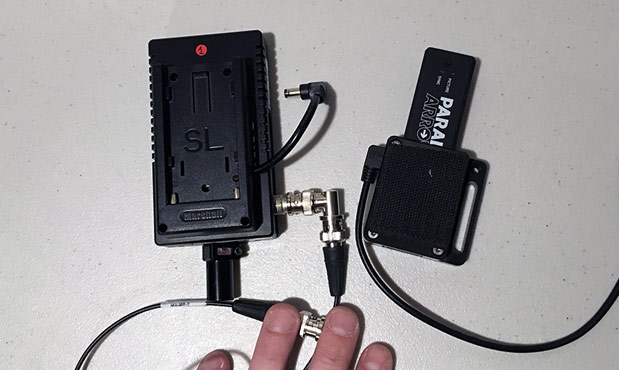
The Ace transmitter (with Sony battery plate) next to the old Paralinx Arrow. The Ace is bigger and a tad heavier, but I found the difference doesn’t affect everyday use.
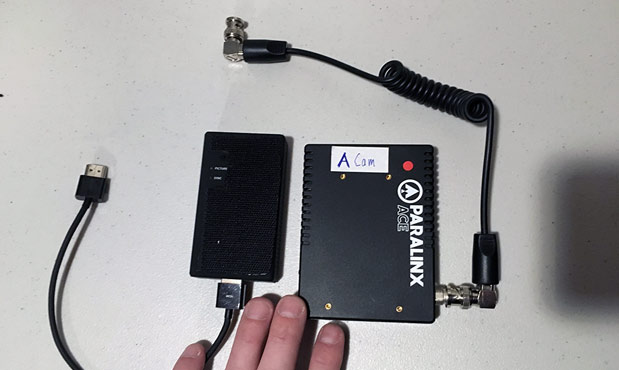
The Paralinx Ace receiver is also noticeably bigger than the old Arrow, but weighs only a couple ounces more and still velcros to any monitor surface.
- Like other wireless units I’ve tried over the years (the Paralinx Arrow and Triton, the Teradek Bolt), the Ace doesn’t have problems working through a conventional, residential wall or closed door, but you can lose your signal through a couple of walls together, or thick concrete. But if the Ace does lose signal, walking back into range will bring it back automatically within a few seconds (note: I did notice that one of my Ace receivers sometimes struggles to reacquire a signal automatically, so I’ve had to pull out its power plug for a moment to get it back online. Paralinx tech support wants to take a look as soon as I can get some downtime!).
- If you do have to troubleshoot a problem, the Ace makes it pretty easy thanks to status LED lights on both the transmitter and receiver that show if the unit is getting power, has a wireless link to its counterpart, and has a video signal from the camera. Between these, it’s pretty obvious what to examine in your gear chain if the monitor doesn’t get a picture.
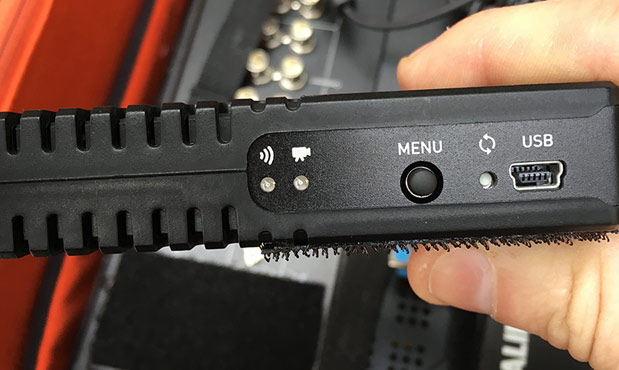
- It’s also pretty easy to change settings on the Ace, largely if you need to break a pairing between devices and then repair them later on. The Ace’s receiver includes a little thumb stick that you can press to bring up a simple menu and diagnostic information on whatever screen it’s attached to, so you can make changes much more easily. I would say that the menu items themselves could be a little more self-explanatory but maybe Paralinx can address that in a firmware update (speaking of which, there’s a mini USB port on each device for making updates).
- To power the units, you can always use an included cable to power them from a bigger battery’s d-tap (you get one cable per package, so if you want to power both transmitter and receiver this way, you’ll need to buy a second cable for $40) . But you can also buy battery plates from Paralinx to use smaller batteries, such as Sony L-series batteries, Canon LP-6 batteries, Canon BP batteries, etc. Personally, I installed Sony L series plates on my transmitters, and use small Sony NP-F570 batteries when I want to use the cameras without a bigger V mount battery attached. Those Sony batteries power a transmitter for 3 hours.
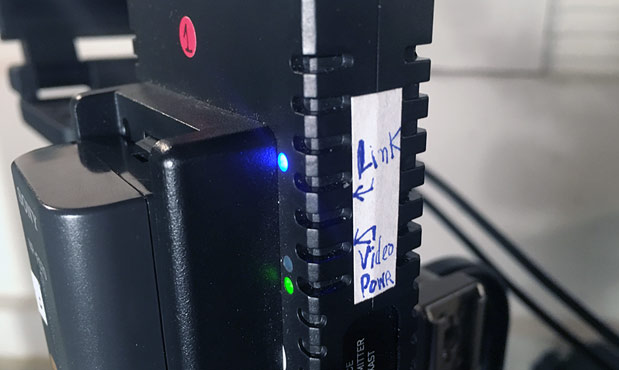
The Ace’s battery plates are helpful, but once installed on a transmitter, they cover up the icons that identify each status LED, so I had to create my own cheat sheet.
- For mounting the transmitter and receiver to camera or monitors, each unit has a single 1/4″x 20 screw hole on the bottom, which isn’t exactly generous but nonetheless workable. For attaching the receiver to a monitor, I find it’s actually a moot point because there’s no better mounting option than simple velcro, which can easily support the receiver’s weight. And for attaching my transmitter to camera, I screwed a 15mm rod spud into the bottom of the transmitter, and then also installed a rotating 15mm receiver on a 15mm rod that’s always on my camera’s trusty Movcam top handle. It’s a great system that lets you install and detach the transmitter quickly, and also rotate it vertically or horizontally depending on how you’re operating the camera. But if you don’t want to go that direction, Paralinx sells a $50 mounting bracket that gives you a couple of 1/4″x 20 holes at a right angle from the original.
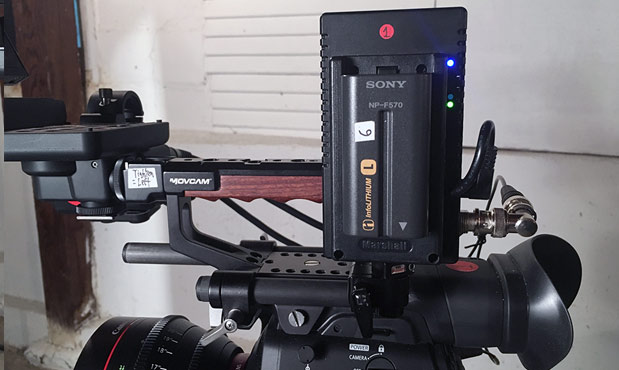
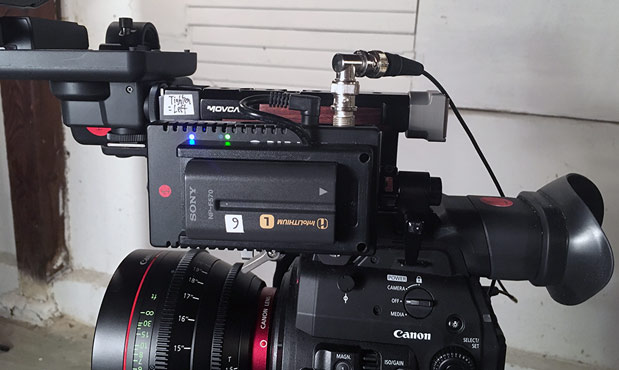
I settled on this mounting solution, which puts the Ace transmitter on a 15mm rod (attached to my top handle) and lets me rotate the transmitter up or down depending on the situation.
COMPARED TO THE TERADEK BOLT
Here’s something you might not know: Teradek, which makes the popular Bolt wireless video system, is owned by The Vitec Group, which also bought Paralinx in 2015. So the two companies are competing and complimenting each other under the name umbrella.
Anyway, when I was doing my shopping, I naturally considered the Bolt as well, but ended up choosing the Ace because it felt like it made my money go farther, especially since I was buying transmitters for two cameras and three receivers (one for a handheld monitor, and two for a remarkable 17” field monitor that can show two camera angles together). With that level of gear, saving a few hundred dollars on each component adds up.
To Teradek’s credit, it’s done a good job of building the Bolt into an ecosystem. There’s a Bolt 300, 600 and 2000 (the numbers refer to their range), and the Bolts also have some value-added features. For instance, most Bolt receivers have a USB 3 connection that let you connect the receiver directly to a computer, so you can capture the image with recording software. Also, Bolt transmitters can apply a 3D LUT to their signals, so any monitor receiving them can see a graded image if you’ve bothered to set that up.
But those extras aren’t essential to me, I just need a solid wireless system (and for the record, most of my monitors can apply their own 3D LUTs anyway). Plus, the Teradek Bolt hardware is noticeably heavier than the Paralinx Ace — for instance, the Ace SDI transmitter is 146 grams, but the Bolt 300 transmitter is 262 grams, which adds up if you’re handholding a camera or gimbal all day. The Ace and Bolt receivers are even more lopsided weight-wise (160 grams vs 346 grams), and while I’m able to velcro Ace receivers to all sorts of equipment, I wouldn’t be as trusting with the heavier Bolt.
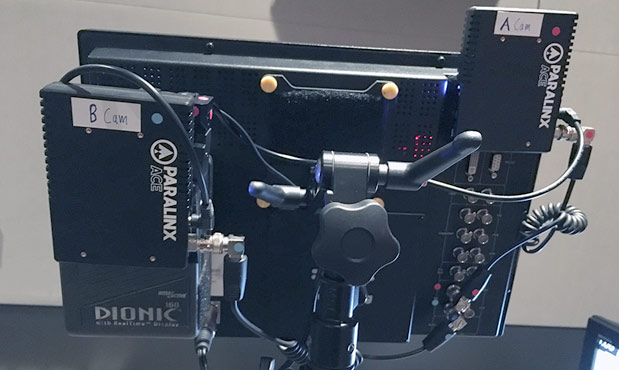
Given the Ace receiver’s low weight, I can velcro two receivers to the back of my Flanders Scientific CM171 17″ field monitor.
And then, again, there’s price: the Teradek Bolt 300 is $2495 for a transmitter and one receiver with SDI connections. If you just wanted HDMI, it would be $1995. But the Ace is $1799 for SDI, and only $1299 for HDMI. That’s a big savings, especially if you want to add a second receiver or make another camera system wireless. And if you do want to add items ala carte, a second Ace SDI receiver would be $950, but $1190 for a Bolt receiver. An ala carte Ace SDI transmitter would be $900 vs almost $1600 for a Bolt.
SUMMING IT UP
The Ace is a very nice blend of performance at a reasonable price. It’s significantly less expensive than the Teradek Bolt, but without skimping on the core features that most people care about. And while it’s not quite as affordable as Paralinx’s old, very popular Arrow, it does offer twice the real-world range of the Arrow, offers SDI support, support for timecode and other metadata, has far more convenient power options, and is not appreciably bigger or heavier than the tiny Arrow. Overall, the Ace is a winner!
Pros
- Good 300 foot range
- Lightweight and small(ish)
- Status LEDs for troubleshooting
- SDI option
- Reasonably priced
- Timecode, start/stops and metadata carried over
- Can mix HDMI and SDI transmitters/receivers
Cons
- No bonus features like LUTs, USB image output, etc.
- Signals from the Ace don’t work with any other Paralinx gear
- Limited mounting options out of the box (one screw at the bottom)

Filmtools
Filmmakers go-to destination for pre-production, production & post production equipment!
Shop Now